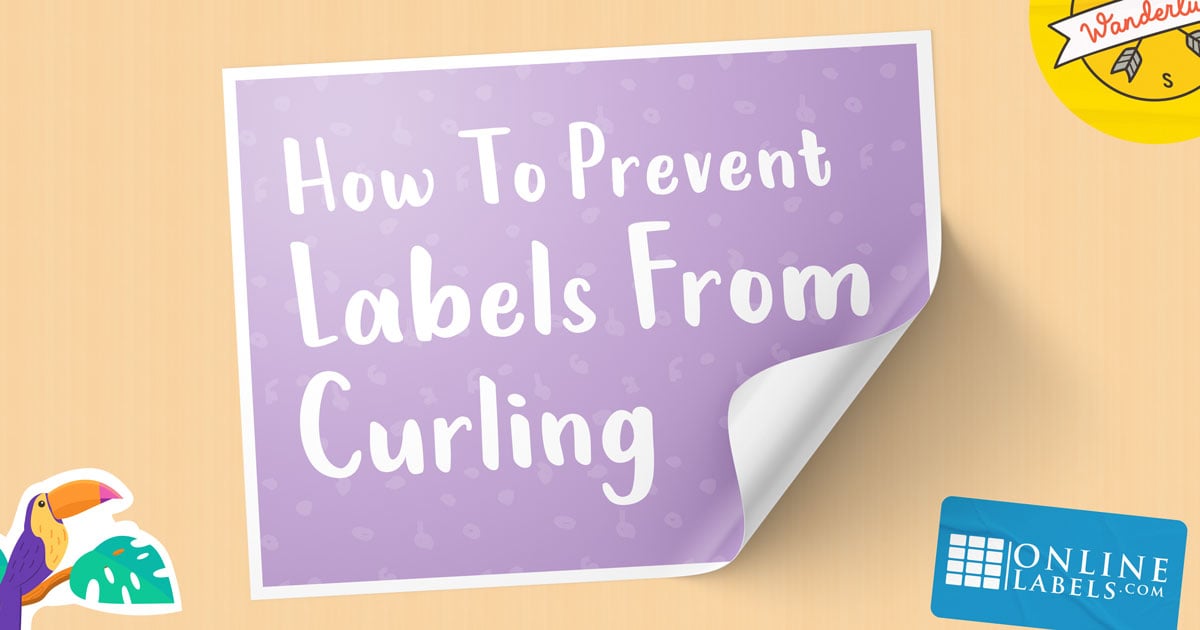How To Prevent Labels From Curling

If you’ve worked with labels or stickers a lot, you know how annoying it can be when your labels curl up, whether it’s when they’re in storage, or after you’ve removed your label from the liner. There’s a whole host of potential reasons for this — it’s a complex issue. Label curling could be due to the environment in which you store your labels, the label material, your container shape and surface texture, and more.
In this article, we’ll go over the different reasons for why labels curl, how to prevent it in each case, and what to do if your labels have already curled. Use the table of contents below to jump ahead.
If Your Labels Curl…
If Your Labels Are Curling While in Storage…
They’re probably not being stored correctly. Since labels are a paper or film product, they’re prone to being affected by environmental conditions in similar ways — and one of the worst things for your labels is humidity. If you live in a climate that is susceptible to humid conditions, your labels are at a growing risk of curling up (and worse) while in storage, the longer they sit there.
It’s important that you store your label stock in a dry, room temperature space (ideally between 62-77 degrees fahrenheit). Wrapping them in plastic wrap can also help protect them from curling and other issues. A good rule of thumb is to keep your labels, whether on sheets or rolls, in the packaging they came in. This is typically some sort of plastic wrap, or, from OnlineLabels.com orders, a clamshell.
Some other storage tips to keep in mind:
- Store your sheet labels laying down flat
- Always use older labels first
- Only keep as many labels in your inventory as you need for the next month or so
But, what if your labels have already curled? Don’t throw them out! You can likely straighten the labels again by working out the curl. Flip the stack of labels over. Take one curled up edge and fold it back (toward you), gently rocking the material back and forth, toward you and away from you, being careful not to create any hard creases. Do this a few times, applying moderate pressure, then repeat on the other edge.
If you notice your stock labels just beginning to curl up, simply flipping them over can do the trick and prevent further curling.
If Your Labels Curl While Being Removed From the Label Liner…
Try peeling your labels from a different direction. This phenomena may seem like a normal or even expected thing when dealing with labels, but it can actually make it more difficult for the labels to stick to surfaces, especially curved ones. Peeling your labels off the liner with the grain will do a lot to prevent curling.
"With the grain" refers to the direction of the fibers making up the label material. Typically, the majority of the fibers will be facing the same direction. Try finding the direction on your label material, and peeling the labels off the liner parallel with the grain as opposed to perpendicular. For example, if you determine the fibers run top to bottom (or bottom to top), start peeling from either the bottom or top rather than side-to-side.
If you’re unable to find the grain direction, try peeling a label one way, and a second label the other way, then determine which had the better result.
Another tip you can try is to peel the liner back off of the label. Labels are usually peeled up off the liner, but this can potentially stretch the fibers in the material beyond their elastic limit, causing them to curl. To do this, keep the label you want straight, while peeling the liner away from the label.
If Your Labels Are Curling Up off Your Container…
There are a few reasons for this, and we’ll break down each one.
- As mentioned above, this could be happening because the label curled while you peeled it from the liner.
- Your label material may be too thick or hard. Label materials that are harder to bend won’t stick to a surface as well, especially a curved surface. Opt for something more lightweight and pliable. Also keep in mind that extra layers of laminate can also decrease a label’s flexibility.
- Your label has square corners. Using a label with rounded corners is not only more popular than sharp, but it also helps prevent butterflying at the corners.
- The container isn't clean. Making sure the container surface is thoroughly cleaned and dried before applying the label will allow for a strong adhesion.
Adhesive Issues
You may not be using the right adhesive for your needs. Some adhesives have trouble sticking on rigid or textured surfaces (like cardboard), as well as containers with tight radiuses. Using a material with an aggressive adhesive can eliminate this issue. For containers with tight radiuses, we also recommend having a sliver of label overlap around the back, since the material will cling to itself well.
If your label stock has been sitting in storage for too long, it’s possible that the adhesive has become hard or weakened. Don’t let your labels sit for longer than one year.
It’s also worth mentioning that adhesives can weaken over time and when exposed to certain elements, even after the label has been placed on the product. If your product will experience heavy handling, moisture, chemicals, cold temperatures, or sunlight, choosing a weatherproof material is the way to go. These feature permanent adhesives that are capable of enduring these conditions. For ultimate protection, use our aggressive white material, which features an even stronger adhesive (our strongest).
We hope you have a better understanding of this common issue and feel ready to take preventative measures against it. Doing this will both help your business processes to run much smoother, and give your labels long-lasting, professional results.
Have any other label-related questions? Our customer service team is ready to help at 1-888-575-2235.


